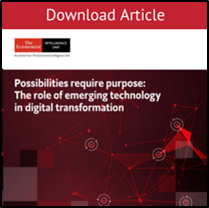In theory, new technologies drive digital transformation, but CIOs often find it’s not that easy. In fact, adopting new technologies to drive business results requires the CIO’s strategic involvement from the very beginning, from choosing the technologies to ensuring they’re working effectively across the enterprise.
“The CIO must be totally cognizant of all emerging technologies and solutions coming onto the market,” says Ritesh Sarda, CIO of Sun Life Financial Hong Kong. “But at the same time, technologies that fail to solve a relevant business problem are absolutely useless.”
Indeed, a recent survey of CIOs conducted by executive recruiter Harvey Nash and professional-services firms KPMG found that enterprise digital strategies were described as “very effective” by fewer than one in five IT leaders [1]. In another survey, conducted by IT advisory firm Gartner, more than 90% of respondents said their organisations haven’t yet reached “transformational” levels of maturity with data analytics, even though those companies’ CIOs have identified that technology as their number one investment priority [2].
Innovating with the customer in mind
Some CIOs, however, are doing an excellent job of identifying and evaluating new technologies for digital transformation. Increasingly, their organisations are doing the same with customer-facing products and services and implementing new technologies across their companies’ operations.
That’s the case at Whirlpool. The world’s leading home-appliance provider, Whirlpool ships more than 70m products a year, many of them digitally enabled. Various Whirlpool appliances now interact with artificial intelligence (AI) tools for analytics, automatic ordering services and several virtual assistants for voice control. Renata Marques, CIO of Whirlpool Latin America, and her IT team recently helped to develop a “smart” beer cooler, not yet on the market, that replenishes consumers’ beer supplies by detecting when beer is running out, then automatically ordering more from a partner marketplace. Moreover, the company recently acquired a mobile app called Yummly; it uses image recognition to inventory the food in a consumer’s pantry, then recommends recipes using only those ingredients on hand.
Ms Marques has encouraged her teams to leverage new technologies for consumer-facing innovation. The Latin America division, based in São Paulo, Brazil, brings in roughly a quarter of Whirlpool’s global sales, which totalled US$21bn last year. “Because digital transformation is part of our strategic agenda,” Ms Marques says, “our IT organisation works closely with engineering, marketing and other business areas.”
And Ms Marques is also adopting Agile, a methodology borrowed from software development, to speed up her new IT projects. Her team recently evaluated a new web platform using an Agile concept known as MVP. Short for minimum viable product, it provides just enough features to garner user feedback. “Agile is something we’ve worked on a lot,” Ms Marques says, “to not just speed up our process, but also create our future of innovation.”
For Ms Marques, “creating a future of innovation” includes a cloud-first strategy that has been key to helping her IT group meet business needs. For example, using the cloud, Whirlpool Latin America recently implemented a new commerce platform for its KitchenAid home appliance brand to improve the consumer experience. The project, though massive, was completed in less than five months. “Without our cloud-first strategy,” Ms Marques says, “we could never have delivered such a big project so quickly.”
Partnering for innovation
Partnerships are another way for CIOs to implement emerging technologies for digital transformation. It’s an approach that works well for Sun Life Financial, a Toronto-based provider of insurance, wealth and asset-management solutions to individuals and corporate clients.
Due to Sun Life’s size—it has 33,000 employees, offices in over 25 countries and assets under management in excess of C$930bn (US$736bn)—moving quickly on new technologies can be a challenge. “As a large enterprise, sometimes we cannot innovate that far,” says Mr Sarda, who joined Sun Life in 2006 and became CIO of its Hong Kong unit in 2016. “So we partner with accelerators and incubation centres where we can pick fintechs and partner with them to evolve a business idea.”
These partnerships have led to some innovative results. One partnership has resulted in Sun Life’s adoption of software robotic automation, also known as “tech bots”, to process customer applications that previously involved lots of painstaking paperwork. The software robots now mimic the work previously done by humans, including underwriting, examining historical records and reviewing claims records. “Where there are inherent system deficiencies, we can create bots rather than putting humans in to do the dirty jobs,” Mr Sarda says.
Another project enhanced by partnership is Sun Life’s implementation of chatbots. These AI implementations populate a website to answer customers’ frequently asked questions. Partners are also now working with Sun Life on blockchain, a platform for decentralised applications, and facial-recognition systems for identity authentication. At any given time, Mr Sarda and his team are partnering with as many as ten specialist companies. “Then,” he adds, “we see which ideas eventually become mature.”
DIY tech
At Intermountain Healthcare, a not-for-profit health system based in Salt Lake City, Utah, CIO Marc Probst and his team have taken a different approach to new technologies: they build what they need and then turn their solutions into new products and services for the company.
One internally developed IT innovation at Intermountain has even led to the formation of a separate company. Called Empiric Health, it offers software designed to help surgical teams control their costs by assessing how different procedures like supply utilisation or staffing affect health outcomes. “That was actually a piece of software we wrote for our internal operating rooms,” Mr Probst says. “We found it was saving us tens of millions of dollars a year, so our people said, ‘Hmm…this may be something of value to other organisations.’”
And using emerging technologies to drive business innovation can also help create better outcomes for patient health. For example, Intermountain clinicians developed a care process model to guide care provision for acute respiratory disease syndrome (ARDS), an illness that’s often fatal. While the model reduced mortality rates, Mr Probst’s team was able to leverage AI and Intermountain’s data to not only replicate the model for ARDS but also identify additional risk factors to further improve the quality of care.
“That’s one of the very real powers of AI. It took what would have taken months or years and allowed it to happen in days,” says Mr Probst.
As Intermountain shows, digital transformation involves shifting advanced technology beyond the IT department’s walls, bringing IT and the business ever closer. Although sometimes challenging, the introduction of new tech offers meaningful change for patients, providers and staff.
Putting it all together
Though every organisation is at a different stage of their transformation, there are several practices CIOs can keep in mind along the way:
- Stay aware of new technologies and potential use cases to meet new customer demands;
- Leverage partnerships for innovation to pool resources and take risks; and
- Be creative about translating IT solutions into business innovations.
In the end, the opportunities offered by emerging technologies may be well worth their weight in gold.
To learn more about the Pioneering Leadership programme, find a full range of insights, including more Q&As, articles and an in-depth report, here.









